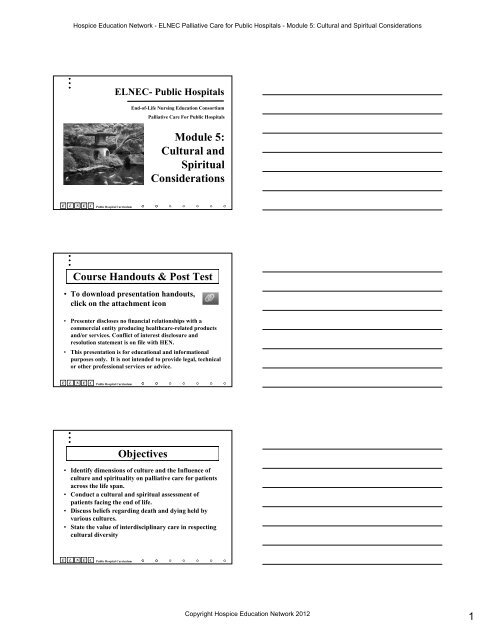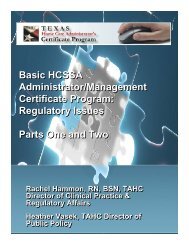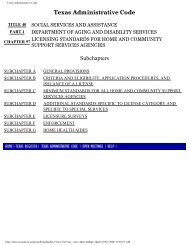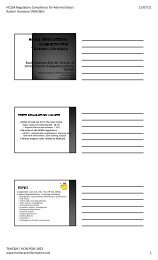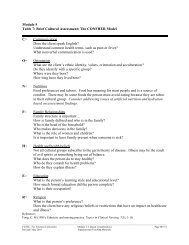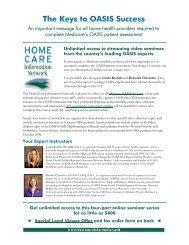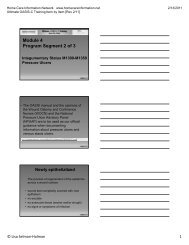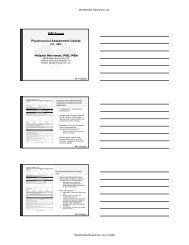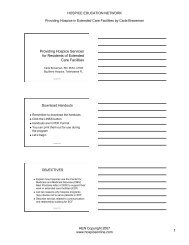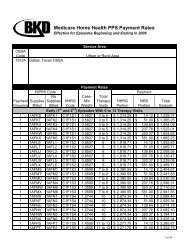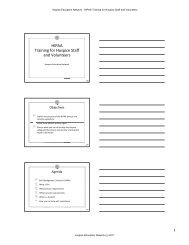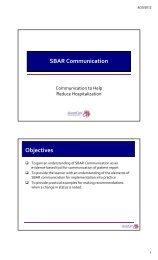Cultural and Spiritual Considerations - Home Care Information ...
Cultural and Spiritual Considerations - Home Care Information ...
Cultural and Spiritual Considerations - Home Care Information ...
Create successful ePaper yourself
Turn your PDF publications into a flip-book with our unique Google optimized e-Paper software.
Hospice Education Network - ELNEC Palliative <strong>Care</strong> for Public Hospitals - Module 5: <strong>Cultural</strong> <strong>and</strong> <strong>Spiritual</strong> <strong>Considerations</strong>ELNEC- Public HospitalsPalliative <strong>Care</strong> For Public HospitalsModule 5:<strong>Cultural</strong> <strong>and</strong><strong>Spiritual</strong><strong>Considerations</strong>E L N E C Public Hospital CurriculumEnd-of-Life Nursing Education ConsortiumCourse H<strong>and</strong>outs & Post Test• To download presentation h<strong>and</strong>outs,click on the attachment icon• Presenter discloses no financial relationships with acommercial entity producing healthcare-related products<strong>and</strong>/or services. Conflict of interest disclosure <strong>and</strong>resolution statement is on file with HEN.• This presentation is for educational <strong>and</strong> informationalpurposes only. It is not intended to provide legal, technicalor other professional services or advice.E L N E C Public Hospital CurriculumObjectives• Identify dimensions of culture <strong>and</strong> the Influence ofculture <strong>and</strong> spirituality on palliative care for patientsacross the life span.• Conduct a cultural <strong>and</strong> spiritual assessment ofpatients facing the end of life.• Discuss beliefs regarding death <strong>and</strong> dying held byvarious cultures.• State the value of interdisciplinary care in respectingcultural diversityE L N E C Public Hospital CurriculumCopyright Hospice Education Network 20121
Hospice Education Network - ELNEC Palliative <strong>Care</strong> for Public Hospitals - Module 5: <strong>Cultural</strong> <strong>and</strong> <strong>Spiritual</strong> <strong>Considerations</strong>• System of shared symbolsCulture Defined• Provides security, integrity,belonging• Constantly evolving• Making meaning of illness• Not limited to race orethnicityE L N E C Public Hospital CurriculumSocial Characteristics of US (CA)• Bachelors degree or higher =27.5% (29.7%)• Foreign born = 12.4%(26.8%)• Speaks a language other thanEnglish at home = 19.6%(42.2%)US Census Bureau, 2005-2009E L N E C Public Hospital CurriculumEconomic <strong>and</strong> HousingCharacteristics: US (CA)• Median household income (in 2009inflation-adjusted dollars) = $50,221($58,925)• Individuals below poverty line = 14.3%(14.2%)• Owner-occupied housing units = 66.9%(57.9%)• Median value of housing = $185,400($479,200)US Census Bureau, 2010E L N E C Public Hospital CurriculumCopyright Hospice Education Network 20122
Hospice Education Network - ELNEC Palliative <strong>Care</strong> for Public Hospitals - Module 5: <strong>Cultural</strong> <strong>and</strong> <strong>Spiritual</strong> <strong>Considerations</strong>Languages Spoken at <strong>Home</strong> in CA• English = 60.5%• Spanish = 25.8%• Chinese = 2.6%• Tagalog = 2.0%• Vietnamese = 1.3%• Over 200 languages arespoken/read in CAUS Census Bureau, 2000E L N E C Public Hospital CurriculumUS (CA): Race/Ethnicity• Non-Hispanic Whites = 74.5%(57.6%)• Hispanic, Latino = 15.1%(37.6%)• Asian = 4.4% (13.0%)• African American = 12.4%(6.2%)• 2 or more races = 2.2% (3.5%)US Census Bureau (2005-2009)E L N E C Public Hospital CurriculumCA: Religions• Protestants = 36%• Roman Catholics = 31%• Latter Day Saints = 2%• Jewish = 2%• Muslims = 1%• Other = 4%• Non-Religious = 21%Pew Forum on Religion & Public Life, 2008; Wikipedia, 2011E L N E C Public Hospital CurriculumCopyright Hospice Education Network 20123
Hospice Education Network - ELNEC Palliative <strong>Care</strong> for Public Hospitals - Module 5: <strong>Cultural</strong> <strong>and</strong> <strong>Spiritual</strong> <strong>Considerations</strong>Americans & Health InsuranceThose With Insurance• 78% have insurance• College degrees• White collar jobs• Receptive to health relatedproducts/concerns• Exercise (bike, golf, usetreadmills)• Buy vitamins• Eat high fiber, low fat• Regular check-ups withMDThose Without Insurance• Live in small towns, ruralcommunities• Modest education• Blue collar jobs• Earn below $25,000/year• Live in low-rise apartments• Roller skate, play bingo, <strong>and</strong>love gospel music• 25% are African Americansor HispanicsThe Nielsen Company, 2011E L N E C Public Hospital CurriculumUS Cities With/Without HealthInsuranceTop US Cities WithInsurance• #1: Juneau, AK• #2: Honolulu, HI• #3: San Francisco, CA• #4: Washington, DC• #5: Fairbanks, AK• #12: Santa Barbara, CA• #17: San Diego, CA• #20: Sacramento, CATop US Cities W/outInsurance• #1: Greenwood-Greenville, MS• #2: Harlingen, TX• #3: Meridian, MS• #4: Columbus, MS• #5: Hattiesburg-Laurel, MS• (No CA cities listed in top 20)The Nielsen Company, 2011E L N E C Public Hospital Curriculum<strong>Home</strong>lessness in America• On average, US cities arereporting a 12% increase inhomelessness since 2009• ~643,000 people experiencehomelessness (1/20Americans)• 58% live in shelters <strong>and</strong>42% are unshelteredUS Department of HUD, 2009E L N E C Public Hospital CurriculumCopyright Hospice Education Network 20124
Hospice Education Network - ELNEC Palliative <strong>Care</strong> for Public Hospitals - Module 5: <strong>Cultural</strong> <strong>and</strong> <strong>Spiritual</strong> <strong>Considerations</strong>State of Children: DemographicsUS (CA)– 20% (20%) live in poverty(household annual income$22,350 or less)– 23% (48%) live with immigrantfamilies– 31% (34%) live with familieswhere no parent has full-time,year-round employment– 1.5% (1.1%) born with “verylow-birth weight”– 13% (28%) crowded housingAnnie E. Casey Foundation, 2011E L N E C Public Hospital CurriculumState of Children Demographics (cont):US (CA)• 97% (94%) are UScitizens• 10% (11%) areuninsured• Total Medicaidspending 20.5%(18.6%)Kaiser Family Foundation, 2008E L N E C Public Hospital CurriculumMortality Rates & Causes forInfants/Children/Teens: US (CA)• Infant mortality: 6.8(5.2)/1000 live birth• Child deaths: 19(16)/100,000 deaths• Teen deaths: 62(52)/100,000 deathsAnnie E. Casey Foundation, 2011• Top 5 causes of death– #1: Unintentional injury(motor vehicles,drowning, fire/burns)– #2: Malignant neoplasms– #3: Congenital anomalies– #4: Homicide– #5: Heart diseaseCDC, 2011E L N E C Public Hospital CurriculumCopyright Hospice Education Network 20126
Hospice Education Network - ELNEC Palliative <strong>Care</strong> for Public Hospitals - Module 5: <strong>Cultural</strong> <strong>and</strong> <strong>Spiritual</strong> <strong>Considerations</strong>US: Status of the Elderly• 39.6 million Americans are 65or older (1/8 of population)• Median income = $25,877(men)-$15,282 (women)• Nearly 3.4 million elderly(8.9%) live below the povertylevelUS Department of Health & Human Services, 2010E L N E C Public Hospital CurriculumUS Status of the Elderly (cont)E L N E C Public Hospital Curriculum• Those 85 <strong>and</strong> older arefastest growing segment• Co-morbidities(i.e. arthritis, hypertension,heart disease, hearingimpairment)• 23% over 85 live in aninstitution• 43% of those over 65 diedin a hospitalDerby et al., 2010<strong>Cultural</strong> Competence<strong>Cultural</strong>Awareness<strong>Cultural</strong>DesireComponentsof <strong>Cultural</strong>Competence<strong>Cultural</strong>Knowledge<strong>Cultural</strong>Encounters<strong>Cultural</strong>SkillCampinha-Bacote, 2003E L N E C Public Hospital CurriculumCopyright Hospice Education Network 20127
Hospice Education Network - ELNEC Palliative <strong>Care</strong> for Public Hospitals - Module 5: <strong>Cultural</strong> <strong>and</strong> <strong>Spiritual</strong> <strong>Considerations</strong>Components Within Culture• Ethnicity• Race• Gender• Age• Religion <strong>and</strong> spirituality• Sexual orientationE L N E C Public Hospital CurriculumComponents Within Culture(cont.)• Differing abilities• Financial status• Place of residency• Employment• Education level• Cause of deathE L N E C Public Hospital CurriculumComponents of <strong>Cultural</strong> Assessment• Patient, family, community–Birthplace–Ethnic identity–Community–Decision making–Language <strong>and</strong>communicationE L N E C Public Hospital CurriculumCopyright Hospice Education Network 20128
Hospice Education Network - ELNEC Palliative <strong>Care</strong> for Public Hospitals - Module 5: <strong>Cultural</strong> <strong>and</strong> <strong>Spiritual</strong> <strong>Considerations</strong>Components of <strong>Cultural</strong>Assessment (cont.)• Food preferences, prohibitions• Economic situation• Health beliefs regarding–Death–Grief–Pain–Traditional therapies–<strong>Care</strong> of the body–Organ donationE L N E C Public Hospital Curriculum<strong>Cultural</strong> <strong>Considerations</strong> of<strong>Spiritual</strong>ity <strong>and</strong> ReligionE L N E C Public Hospital Curriculum• <strong>Spiritual</strong>ity– Meaning-making– Need for purpose ,forgiveness, love, hope,relatedness <strong>and</strong> religiousfaith– Transcendence• Religion– “Organized”– Institutional beliefsJohnston, 2010FICA: An Example of A <strong>Spiritual</strong>Assessment• F = Faith• I = Importance,influence• C = Community• A = AddressPuchalski & Romer, 2000E L N E C Public Hospital CurriculumCopyright Hospice Education Network 20129
Hospice Education Network - ELNEC Palliative <strong>Care</strong> for Public Hospitals - Module 5: <strong>Cultural</strong> <strong>and</strong> <strong>Spiritual</strong> <strong>Considerations</strong>Nurse’s Self Assessment of Culture• Self assessment• <strong>Cultural</strong> beliefs ofco-workersE L N E C Public Hospital Curriculum<strong>Cultural</strong> <strong>Considerations</strong> ofCommunication• Conversation styles• Personal space• Eye contact• Touch• View of healthcareprofessionals• Learning styles• Language/gesturesE L N E C Public Hospital Curriculum• Who makes thedecisions?Role of the Family• Who is included indiscussions?• Is full disclosureacceptable?E L N E C Public Hospital CurriculumCopyright Hospice Education Network 201210
Hospice Education Network - ELNEC Palliative <strong>Care</strong> for Public Hospitals - Module 5: <strong>Cultural</strong> <strong>and</strong> <strong>Spiritual</strong> <strong>Considerations</strong><strong>Cultural</strong> Influences on DecisionMaking• Beliefs about autonomy <strong>and</strong> othervalues differ• Disclosure of diagnosis <strong>and</strong>prognosis• Ascertain desire for disclosureE L N E C Public Hospital CurriculumLanguage Used at the End of Life• “Discontinuation”• “DNR”• “Withdrawing/withholding”E L N E C Public Hospital CurriculumWhen Cultures Clash• Clashes occur• Assess your reactions• Never lie• Offer information• Use cultural guidesE L N E C Public Hospital CurriculumCopyright Hospice Education Network 201211
Hospice Education Network - ELNEC Palliative <strong>Care</strong> for Public Hospitals - Module 5: <strong>Cultural</strong> <strong>and</strong> <strong>Spiritual</strong> <strong>Considerations</strong>• Culture is a majorinfluence on end-of-lifecare• Self assessment ofculture• Many dimensions ofculture• <strong>Cultural</strong>ly sensitivecare• Interdisciplinary careE L N E C Public Hospital CurriculumConclusionCourse H<strong>and</strong>outs & Post TestThank you for viewingthis course on theHospice Education NetworkThe Course evaluation <strong>and</strong> post test areavailable from your course catalog pageTo achieve credit for this course,close the video portion whencompleted <strong>and</strong> click on Start TestE L N E C Public Hospital CurriculumCopyright Hospice Education Network 201212


